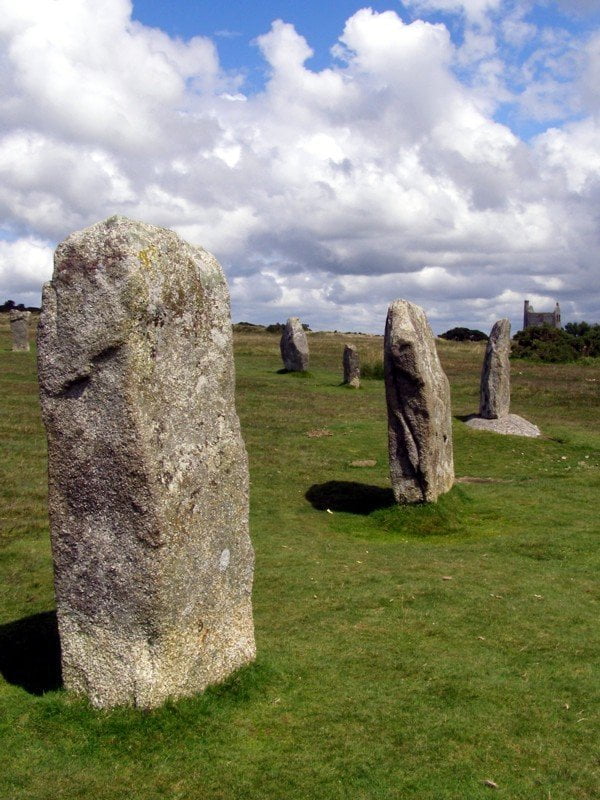Many superstitions are common to several parts of Britain, but some have their roots in specific areas. The ones I intend to talk about are rooted in Cornwall, starting in the far west on the Isles of Scilly.
In Porth Hellick there is a barren spot of land, surrounded by luxuriant grass. The grass never encroaches on this spot as it is said that God would never allow anything to grow there. On 22nd October, 1707, several ships were wrecked off Scilly. The admiral of the fleet, Sir Cloudsley Shovel, had refused to listen to the advice of local seaman and so was said to be responsible for this tragedy. He was temporarily buried in a certain spot. Yes, the same barren spot of Porth Hellick.
As recently as the thirties, one old custom prevailed in St. Ives. This was a ritual to ensure the luck of a newly baptised child. “Kimbly”, a sort of bread, or “Cheeld’s Fuggan”, a saffron cake containing currants, was carried by relatives of the infant and was thrust on the first person, who was the opposite sex to the child, whom they met on their way from the church.
A man who shot a raven on Marazion Green was reproved by an old man who told him that King Arthur was still alive in the form of that bird. The same belief was also accorded to the chough, and it was considered very unlucky to kill either bird.
Towednack was a last refuge of many superstitions. It was said that spring was brought to Cornwall there during a cold and wintry April. A farmer invited friends to sit by his fire and threw a hollow log onto flames. A cuckoo flew out and the weather immediately became warm and spring like. Following this episode, a Cuckoo. Feast was held each year on the Sunday nearest to 28th April.
Yet another Towednack farmer missed some of his property and was determined to discover who had stolen it. He invited all his neighbours to touch a trivet beneath which a cock had been placed, saying: “In the Name of the Father, Son and Holy Ghost, speak.” One nervous old woman touched the trivet and the cock crowed. The woman later confessed to the theft.
In nearby Nancledra, there used to be a logan stone which rocked only at midnight. Children suffering from rickets were cured if laid on the stone and rocked, but this only worked if they were born in wedlock. The stone would not rock for the illegitimate. These logan stones were said to be favourite meeting places of local witches, who rode there on ragwort stems. Anyone wanting to be a witch had to go secretly at midnight to the stone and touch it nine times.
Nine was a magical number in the world of superstition. It was the number of times one should crawl on all fours through the Crick or Creeping Stone at Madron to cure lumbago. Of course, the crawling had to be “widdershins” or against the sun, and the sufferer had to be well enough to crouch on hands and knees!
A similar ceremony took place at Men-an-Tol, where ailing children were passed through the holed stone.
In 1925, a certain field near Mullion had never been ploughed because it was believed to be an ancient burial site. The local people believed that whoever disturbed the land would suffer the loss of his eldest son or endure some equally severe misfortune.
As recently as 1949, a Cornish woman was observed making a sacrifice as her husband was dying. She took a black cock to the window and wrung its neck. She explained that it was so the cock could accompany her husband’s soul to the gates of heaven. When St. Peter saw the cock, it would remind him of his denial of Christ and move him to mercy so that he would allow her husband through the heavenly gates!
Towards the end of the First World War, strange lights were seen along the Cornish coast. These were said to be flashed by a Cornishman who had been drowned by German submarine action. Like the lamps of the old wreckers, they lured ships to destruction – but not all ships. The lights were only sighted by German ships and submarines.
Any breach of the local moral code called for “Rough Music”, a noisy, unruly demonstration which invariably drove the offender from the community. Such offences as adultery and incest were unofficially punished in this way. In 1880, six men of Stoke Climsland were prosecuted for causing an obstruction in this way. Their lawyer pleaded ancient custom and only small fines were imposed. I wonder whether such a plea would hold today, and I wonder how many of these beliefs still lurk in hidden corners of Cornwall.
Nine Maidens stone row is an ancient monument in the parish of Four Lane near Reduth and there is a local myth about the creation of the stones suggests that nine maidens were turned into stone as punishment for dancing on a Sunday. There other stone circles in Cornwall with the same name and the same legend. These legends are often associated with stone circles, and is reflected in the folk names of some of the nearby sites, for example The Merry Maidens near Penzance plus The Hurlers and The Pipers on Bodmin Moor.

Do you know any more superstitions?
If you do please let us know. Thank you